Rice
Rice (dhan) a cereal food plant, Oryza sativa, of the grass family Gramineae, extensively cultivated in warm climates, especially in East Asia, producing seeds that are cooked and used as food. The word Ouliz of the Ningpo dialect of old Chinese language became Oruz in Arabic and Oryza in Greek languages which were changed to Ritz and Rice. Origins of the words dhan, dhanya is not known. Rice, the staple cereal of millions of people, is a crop of antiquity. Under the patronage of the kings of China and Japan rice began to be cultivated about 10,000 years ago. This crop has a wider adaptability and grows from North Korea to South Australia and from sea level to an elevation of about 2,600 m (Jumla, Nepal).
Rice is cultivated in Bangladesh throughout the year as Aush, Aman or Boro. Aman (broadcast and transplanted) is generally cultivated in December-January, Boro in March-May, and Aus in July-August cropping seasons. Among these croppings transplanted Aman is most important and occupied about 46% of the rice cultivated land in 2009-10.
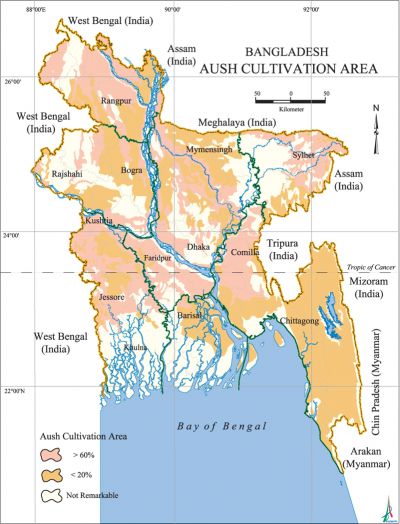
The rest 41, 9 and 4 percent of the land is occupied by Boro, Aus and sown Aman respectively. Transplanted Aman is grown throughout Bangladesh and sown or broadcast Aman is grown mostly in the south and southeastern part of the country. Aus is cultivated scatteredly in most of the districts.
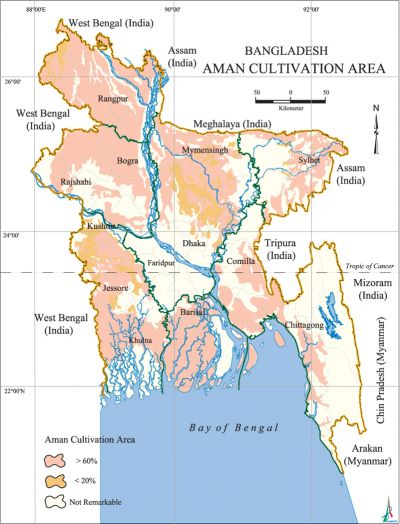
About 40 percent of the world's population derives most of their calories from rice. Almost 90 percent of the population of Bangladesh, Myanmar, Sri Lanka, Vietnam and Kampuchea are rice eaters.
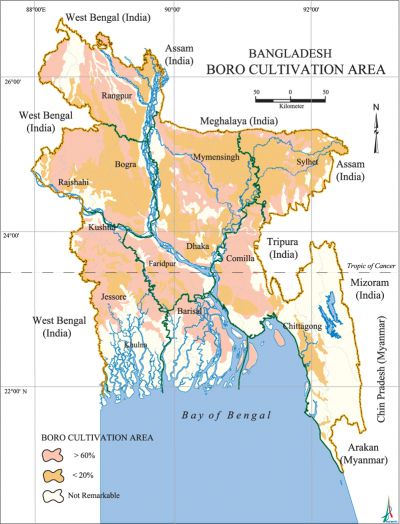
Rice is interwoven with Bangali culture. It is the symbol of wealth. The Food Department of the Government of Bangladesh recommends 410 gms of rice/head/day. In 2009-10, Bangladesh produced about 32 million metric tons of rice. Table shows the statistics of rice production in Bangladesh during 2007-08 to 2009-10. Aman tops the position, followed by Boro and Aus, in area and Boro followed by Aman and Aus in production.
Table Area and production of rice in Bangladesh (2009-10).
| Crops | 2007-2008 | 2008-2009 | 2009-2010 | ||||||
| Area ‘000’ Acres | Yield per Acre (kg) | Production ‘000’ m tons | Area ‘000’ Acres | Yield per Acre (kg) | Production ‘000’ m tons | Area ‘000’ Acres | Yield per Acre (kg) | Production ‘000’ m tons | |
| 1 | 2 | 3 | 4 | 5 | 6 | 7 | 8 | 9 | 10 |
| Aus Rice | |||||||||
| Local | 885 | 461 | 408 | 929 | 481 | 447 | 832 | 472 | 393 |
| HYV | 1385 | 794 | 1099 | 1704 | 850 | 1448 | 1600 | 822 | 1316 |
| Total Aus | 2270 | 664 | 1507 | 2633 | 720 | 1895 | 2432 | 702 | 1709 |
| Aman Rice | |||||||||
| Broadcast | 761 | 377 | 287 | 996 | 464 | 461 | 1175 | 482 | 567 |
| T Local | 3308 | 502 | 1660 | 3444 | 603 | 2077 | 3495 | 640 | 2237 |
| T HYV | 8405 | 918 | 7715 | 9145 | 992 | 9075 | 9323 | 1008 | 9403 |
| T Total | 11713 | 800 | 9375 | 12589 | 806 | 11152 | 12818 | 908 | 11641 |
| Total Aman | 12474 | 774 | 9662 | 13585 | 855 | 11613 | 13993 | 872 | 12207 |
| Boro Rice | |||||||||
| Local | 311 | 724 | 226 | 302 | 720 | 218 | 265 | 807 | 214 |
| HYV | 9119 | 1533 | 13984 | 9341 | 1484 | 13866 | 9671 | 1511 | 14622 |
| Hybreed | 1956 | 1816 | 3552 | 2011 | 1852 | 3725 | 1694 | 1902 | 3222 |
| Total Boro | 11386 | 1560 | 17762 | 11654 | 1528 | 17809 | 11631 | 1553 | 18059 |
| Total Rice | 26130 | 1107 | 28931 | 27872 | 1124 | 31317 | 28057 | 1139 | 31957 |
Husked dhan or paddy is chaul or chal. Cooked chal is bhat. Polao, morog-polao, biriani, tehari, etc are special dishes of aromatic small grains cooked with chicken, beef, mutton, butter oil and spices. Over cooked rice mixed with pulse is khichudi. Pulse and vegetables added to khichudi increase its protein efficiency ratio and therefore is more nutritious.
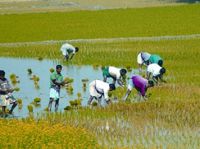
Rice Plant Paddy is the fruit cum seed. When the seed germinates the emerging plumule and radical develop respectively into a stem and adventitious roots. The stem has nodes and internodes. The leaf originates from a nodal bud and consists of a sheath and a long blade. The last leaf is the flag leaf which bears the last internode called rice panicle. This contains florets (Spikelets); usually each flower produces one paddy.
Basal nodes produce branches called tillers, which also bear panicles. HYVs produce more tillers and grains, giving higher yields in comparison with the traditional varieties. Each of the rice groups of Bangladesh has distinct physio-genetical characteristics. Rayda, the progenitor of the Bangladeshi rice groups, is now an endangered group.
Each rice group has many varieties and land-races which are called germplasms. bangladesh rice research institute (BRRI) has about 5,000 such germplasms in their gene bank for use.
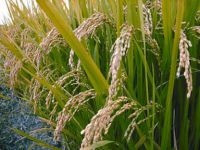
Different forms of processed rice and rice products are consumed in Bangladesh. These are as follows: atap milled rice from sun-dried paddy; shiddhya-chaul rice milled from parboiled paddy; cheeda, khoi and moodi are flattened, puffed and popped products from paddy.
Rice grain or starch is used in the manufacture of cosmetics, cigarette paper and alcoholic beverages. Rice bran produces an edible oil and vitamins and is also used as cattle and poultry feed. Silica rich rice husk is used as an abrasive for polishing gun-barrels. Pure silica extracted from rice husk is used to produce microchips of electronics. Rice straw is extensively used as cattle fodder, for thatching roofs, and for the manufacture of straw boards.
Rice is rich in carbohydrate. The protein content is about 8.5 percent. Rice does not have C and A vitamins. The thiamin and riboflavin contents are 0.27 and 0.12 micrograms respectively.
Taxonomically, rice belongs to the tribe Oryzeae of the family Gramineae. Either O. perennis or O. rufipogon might have been the parent of Oryza sativa (the Asiatic rice) which includes all the present cultivated rice. The 2n number of chromosomes of rice is 24. The wild rice O. officinalis is also found in Bangladesh. Another wild rice locally called Uri-Dhan is found in the saline estuarine coastal areas. The previous name Oryza coarctata has been changed to Porteresia coarctata. This wild rice is collected by coastal people and consumed as a delicacy. It needs improvement for commercial production.
Bangladesh Rice Research Institute (BRRI) was established in 1970 at Gazipur, 36 killometres away from the city of Dhaka, to conduct research on rice. The institute has so far developed 57 high yielding varieties of rice. Currently the production of rice has increased more than three times from a bench mark production of about 10 million tons in 1970-71. [SM Hasanuzzaman and Jahangir Alam]
Deepwater rice Rice grown in more than 50 cm water for one month or a longer period during the growing season. Based on stature and depth of water, these are of two types: (i) traditional tall, and (ii) floating rice. Traditional tall cultivars have long leaves, and are grown at water depths of between 50 and 100 cm; floating rice is grown in 100 cm or deeper situations. In Bangladesh most of the rice grown in low-lying areas during the monsoon season are floating type, generally called deepwater rice, and locally known as jolidhan, poushdhan, etc.
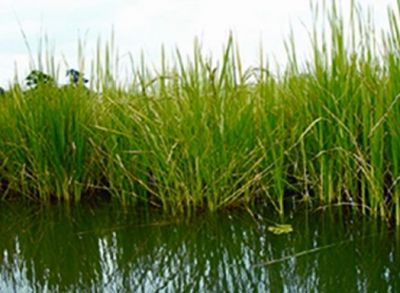
Deepwater rice grown in Asia is a cultiver of Oryza sativa, probably evolved from perennial grass, Oryza rufipogon, via annual wild relative, Oryza nivara. There are more than 2,000 deepwater rice cultivars in Bangladesh and more than 6,000 in Asia. Almost all the deepwater cultivars are strongly photo-period sensitive. Photosensitivity fixes flowering time at a favourable point in the flooding period, enables the plant to escape the adverse effects of low temperature in the reproductive phase, and usually ensures crop maturity as soon as floods have receded. The panicle is often of the awned, spreading type, and seeds are prone to shatter. Seeds have dormancy period lasting for several weeks.
Deepwater (floating) rice has three special adaptations: (i) ability to elongate with the rise of water levels; (ii) develop nodal tillers and roots from the upper nodes in the water; and iii) the upward bending of the terminal part of the plant called ' that keeps the reproductive parts above the water as flood water subsides. Deepwater rice grows under rainfed dry land condition for 2-4 months, before the onset of flood, when the plant produces basal tillers. With inundation, the plant becomes an emergent macrophyte and grows in an aquatic environment for the remaining 3-5 months of its life. Nodal roots absorb nitrogen, phosphorous, and possibly other nutrients from floodwater. There is an increase in the number of elongated internodes with the increase in water depths. Majority of deepwater rice cultivars in Bangladesh is of strong elongators. Stems may reach 5-6 m in very deepwater (3-4m) situations. Deepwater rice does not normally survive water depths greater than 4m.
In Bangladesh, deepwater rice occupied 2.09 million ha (21% of the total rice area) in the late 1960s. The area has now shrunk to about 0.85 million ha because of cultivation of high yielding varieties under irrigation in deepwater rice fields in the dry season (boro). At present, 1.24 million ha remain fallow during the monsoon. Deepwater rice is usually dry seeded in the months of March-April following the first monsoon shower. In some areas, farmers establish deepwater rice by transplanting seedlings following the cultivation of dry season rice. Very little fertiliser is used and weeds are effectively controlled by harrowing and hand weeding, twice before flooding occurs. Crops mature between mid-October and mid-December, depending on the degree of photo-period sensitivity of the cultivar. Grain production tends to increase with the increase in biomass up to 12m tons/ha (dry weight). The harvest index typically varies from 0.12 to 0.16 and tends to increase in shallow water situations. Heaviest panicles are borne on the main tillers followed by basal tillers and lightest panicles by nodal tiller. Panicle density usually varies between 50 and 120 per sq m. Average grain yields are 2.3m tons/ha and some cultivars have the potential of producing yields more than 3.0 m tons/ha. [Zahirul Islam]
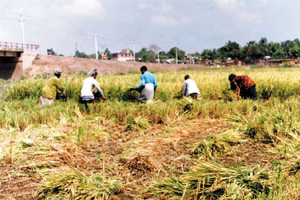
Rice harvesting and threshing Harvesting starts soon after the crop ripens to prevent rot or damage from weather or insects. Rice ripens in different times of the year, depending on variety, so that harvesting of one may begin while the other is yet to reach maturity. In Bangladesh the harvesting time of rice in different seasons are: Aus (July-August), broadcast Aman (November-December), transplanted Aman (November-January), local boro (April-May), and high yielding boro (May-June). Harvesting can either be done manually with the use of hand harvesting tools, or mechanically, with the use of harvesting machines (reaper, harvesters). In Bangladesh rice harvesting is done manually, using sickles (kanchi), consisting of a wooden handle and a knife blade (made of mild steel), the base of which is pushed into the wooden handle. The blade may be 20-30 cm long, having a serrated edge (15 serration per 2.5 cm, with teeth 1 mm long).
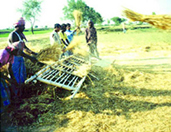 |
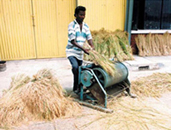 |
| Various methods of rice threshing | |
The plants are cut with about 50 cm of straw and are often dried in the field. If the threshing is to be done later, they are piled into stacks with the panicles placed toward the centre to permit further drying of the grains. The time required to cut and lay aside the plants may be 60-80 man-hour/ha.
Threshing is the removal or separation of grains from the panicles of the paddy stalks. Hand beating, ox treading, or a combination of both; and use of pedal threshers are the common methods of threshing. Foot treading is also practiced in some areas. In hand beating, small bundles are beaten on drums, wooden logs, stones, bare ground or other hard materials. Depending upon bundle size, variety, and physical condition of workers each bundle is beaten 5 to 10 times in order to shatter all grains. In ox treading, bundles are initially placed around, with panicles positioning inward or on one side of the threshing floor. Two to four oxen are generally used in single row in tandem going around the materials being threshed. A man always stays behind to drive the oxen, tied loosely on a pole at the centre, to walk around the threshing floor.
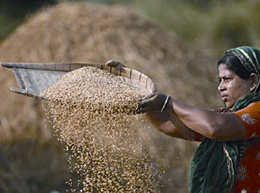
In some areas, no centre pole is placed. The man behind controls the movement of the oxen. Well off farmers sometimes use 6 or 8 oxen in double row in tandem to thresh more materials at a time. As ox treading continues, additional bundles are spread by one or two men, who also take care of turning and shaking the straw from time to time. This continues until all the grains are separated from the straw. Grains are then partially cleaned and removed from the threshing floor.
In most parts of the country, ox-treading is done as a second stage threshing after hand beating to further separate the remaining filled grain and to soften the straw to be used for animal feeds. The time gap between the two stage of threshing operations varies up to 3 month, depending upon the climate, availability of animals, etc. In the Aman season, it usually extends up to 3 months because the weather is cool and dry, and because the paddy and straw have already dried. In Boro and Aus season, however, priority is given to field activities.
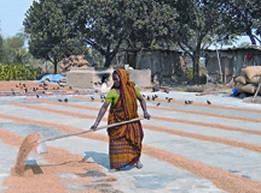
Hand beating and foot-threshing are practiced occasionally when the straw is needed for roofing, the yard is wet and animals are not available; when there are no facilities for ox-treading; and there is an urgent need for food. A pedal thresher is the only mechanical equipment used for threshing paddy.
It is a portable machine, consisting of a strong wire-looped cylinder, driven by foot through a shaft liver and a gear system. The machine is operated by moving the pedal up and down with one foot while harvested stalks are fed on the rotating cylinder. Grains are separated from the panicles with the action of protruding wire loops in the rotating cylinder.
Generally, one helper picks a handful of harvested stalks from the pile, gives them to the operator who thresh while pedalling. The pedal thresher is closely associated with threshing HYVs. In Comilla district where HYV are widely grown, almost all farmers use pedal threshers. It is capable of being operated by women and children anytime and used indoors, particularly during the rainy season.
Pedal threshers are also used by the farmers in the northwest region of Bangladesh, particularly in the Boro and Aus seasons when HYVs are widely grown. Traditional threshing, however, is still widely practiced during the Aman season. Power threshers are also used in some part of the country. [Md. Nurul Islam]
Rice storage Keeping harvested paddy or threshed, dried rice in appropriate places, bins, warehouse or containers for future use and also to prevent deterioration of quality of the grain. The purposes of rice storage are: to provide constant supply of food grain throughout year; to retain viability of the grain for planting in the following season; to take advantages of higher prices offered by traders; and to serve as reserve during times of food scarcity. Stored rice appears to be more relished and hence conventionally some consumers prefer to store rice for a certain period. Rice storage is therefore carried out by the producer, the trader, the processor, the government and the consumer. Rice grain is generally stored from one harvest season to the next for a maximum of one year. However, crop surpluses or government policies might require that the grain be stored for extended periods.
Significant losses in quantity and quality of stored rice occur through the activities of microorganisms, insects, mites, and rodents. Traditional and inefficient methods of harvesting, threshing, drying, storage and processing causes about 13% postharvest loss of the food grain, which is estimated to be about 3.51 million m tons per year. Deterioration of stored rice arises from a variety of causes. However, such losses can be reduced by control of the two most important variables such as, moisture and temperature. Since freshly harvested rice has moisture content of 20% or more, the grain must be dried before storage. At 14%, rice can be stored safely for two to three months. For longer storage, the rice should be dried to moisture content of about 12%.
Storage systems Like all other food grains, rice is stored principally by two methods. These are storage in gunny bags and loose in bulk storage. Although bulk storage facilities in traditional bins and some modern silos are in use in Bangladesh, rice is frequently stored in bags. The bag storage method is more expensive than bulk storage because it requires the purchase of gunny bags; it is more labour intensive and requires more storage space per unit weight of rice. Regardless of the methods of storage, the grain must be dry and clean and must be protected from weather and pests.
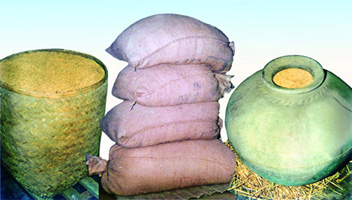
Traditional storage Most rice grains produced in the country are stored in traditional storage structures at farmers level; these account for 70-80% of the total produce. The most widely used rice storage structures in the rural areas of Bangladesh are different types of traditional bins which are used for bulk storage of food grains. These include various types of earthen wares, and bins made of plant materials, especially bamboo.
Earthen containers Various types of earthenwares made of burnt or unburnt clay of different capacities are extensively used for storage of foodgrains, particularly of seed paddy. Containers made of burnt clay are locally known as jala, matki and kola, and are spherical or oval in shape, having a small opening at the top for pouring grains into the vessel. Earthen covers are used for these containers. The capacity of jala varies from 50 kg to 300 kg, while the capacity of Kola ranges from 20 kg to 150 kg. Mud bins locally called kuthi, are made of unburnt clay, and are usually rectangular or circular in shape. The clay is mixed with paddy husk, cow dung and straw. The fibrous materials are used as binder with clay to prevent any cracks on the wall. The mouth of the container may also be sealed or plastered with mud after the vessel is filled with grains. Such a storage may have a small opening at the lower part through which the stored grains can be taken out at the time of need without opening the mouth lid. A kuthi may also have several chambers inside for storing different varieties of rice or other foodgrains separately. Such structures have capacities ranging from 200 kg to 800 kg. The earthen containers are usually placed on the ground or on a platform inside the house.
Bamboo bins These are made of bamboo mats, splits or wattles. The different types of bamboo bins are locally known as dole, ber and dhari, depending on the nature of the construction materials used and the shape of the containers. Bamboo bins are most popular of the storage structures used by farmers. These storage containers are usually located inside a dwelling house and placed on a bamboo frame or on wooden platforms raised 0.5 m to 1.0 m above ground level for protection from ground moisture, rodents and insects. The Dole is usually made of bamboo mats or wattles of stems of Saccharum anundinaceum, locally known as nal. The mats or wattles are continuously woven to give the cylindrical or oval shape of the dole which is open at the top. Sometimes both the inner and outer surface of the dole are plastered with cowdung or with a mixture of cowdung and mud. Its usual capacity ranges from 200 kg to 800 kg.
Ber is a spherical or oval shaped container, made of bamboo splits, opening both at the top and the bottom. A mixture of mud and cowdung is plastered on the inside surface of the ber. A rope, made of straw, is placed at the base of the ber before filling it with grains. The storage capacity of the type of container ranges from 600 kg to 1,600 kg. Dhari is a cylindrical container made of several (2-5) bamboo mats joined together to give it its usual shape and is open both at the top and bottom ends. At every junctions of the dhari, two bamboo splits of desirable strength are fastened by wires to make it cylindrical in shape. Before it is filled with grains, a straw-made rope is placed around the base of the dhari. Its storage capacity ranges from 800 kg to 3,000 kg.
Store house The store house, locally called gola ghar, is a very common structure in rural Bangladesh built for bulk storage of rice. It is usually constructed in the premises of the house and has a thatched roof and a platform raised 0.5 m to 1.0 m above ground level. The walls are made of bamboo wattles plastered with a mixture of cowdung and mud. Sometimes a gola ghar has several chambers, each with a separate door to store different varieties of paddy or foodgrains separately. The capacity ranges from 1,000 kg to 10,000 kg.
Bag storage In addition to above traditional storage structures, many farmers store their rice in gunny (jute) bags. The capacity of each bag varies from 80 kg to 100 kg. The filled bags are piled on a platform in a house built with thatched roofing. Such stores may often be a part of the dwelling house.
Government storage These storage facilities are elaborations of traditional methods, but are constructed with modern materials. There are of two main types: warehouse, and silo bins. Such structures are used in commercial grain storage systems and involve the storage of large quantities of foodgrains by commercial traders and government departments having adequate economic and technical support.
Warehouse In Bangladesh the most common commercial rice storage method is bag storage. This is utilized mainly by rice traders in different types of buildings, made either of bricks or corrugated iron sheets or/and mud and wattle, with or without plastered walls, and with an earthen or cement floor. The warehouses are known as Conventional Godowns. Such godowns are also maintained by government departments. The bagged foodgrain storage systems are named as Local Storage Depot (LSD) and Central Storage Depot (CSD). There are 9 CSDs and 620 LSDs scattered all over the country with storage capacities of about 4 lakh 30 thousand m tons and 11 lakh 50 thousand m tons respectively. Various foodgrains especially paddy, milled rice, and wheat are usually stored by the government in these storage systems. The LSDs are located in the vicinity of Union, Upazila and District headquarters, while the CSDs are located at larger towns/cities and ports.
In Bangladesh, one of the major disadvantages of the bagged storage system is that the readsorption of moisture takes place during the humid wet season, especially in the outer layers of bags. This accelerates biological activity in the grains and results in deterioration and loss of the product. In the hot dry season, when roof and wall surface temperatures are extremely high, foodgrains stacked within one meter of the roof or close to walls become hot. This causes relocation of moisture which results in deterioration of the grain during storage.
Silo Storage A silo is a storage facility with provision for mechanical handling of foodgrains. All silos in Bangladesh are operated by the government. The country has 9 silo storage facilities located at regional levels, particularly in port areas and places where road and transportation facilities are well developed. The total storage capacity of these silo units is about 3 lakh 60 thousand m tons. A silo installation is also known as an 'Elevator', because it is equipped with elevators. [M Shams-Ud-Din]
Diseases All the cultivated varieties of rice suffer from several diseases. Of these, viral, bacterial, fungal, and nematode-borne diseases are mostly prevalent between June and December.
Virus and Mycoplasma diseases Tungro was first recorded in Bangladesh in 1966, and is reported as the most damaging viral disease of Bangladesh. Stunting of the plant along with twisting of the leaves, reduced tillering, delayed flowering etc are the distinguishing features of the disease. The disease is transmitted by leafhoppers, Nephotettix virescens, N. nigropictus, and Recilia (=Inazuma) dorsalis.
Yellow dwarf is a minor disease in Bangladesh. Symptomatically, the leaves, particularly the young and newly emerged ones show general yellowing which follows severe stunting, production of fewer panicles and chaffy grains. The organism is transmitted by insect vector Nilaparvata lugens.
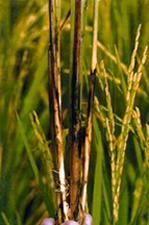 |
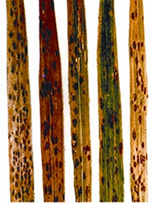 |
| Rice diseases: Stem rot (left); Brown spot (right) | |
Grassy stunt disease caused by phytoplasma shows severe stunting symptoms, and excessive tillering, along with short narrow, light green, or pale yellow erect leaves. Rusty spots are seen on the leaves, often accompanied by chlorosis.
Bacterial diseases Bacterial blight/Bacterial leaf blight In Bangladesh the disease was first noticed in 1966. The disease is caused by a rod shaped gram-negative bacteria, Xanthomonas campestris pv oryzae. In transplanted rice the disease normally appears after six weeks of planting. In the flag leaf, the symptoms are frequently visible. The drying of the leaf usually originates from the tip and extends downwards from both side of the leaf blade and may reach upto the leaf sheath depending on the variety.
Bacterial leaf streak Is caused by Xanthomonas campestris pv. oryzicola. Symptoms are restricted in the leaf. In case of severity of the disease the entire leaf becomes yellow or brownish-red. The disease is seed borne, and the pathogen may overwinter in straw and stubbles.
Fungal diseases As many as 19 fungal diseases have been recorded from Bangladesh. The major and important diseases are the sheath blight, brown spot, leaf scald, sheath rot, blast, bakanae, and stem rot, stack burn, and bunt.
Sheath blight caused by Rhizoctonia solani normally remains restricted to the lower leaf sheaths of older leaves, and no visual damage is noticed.
Brown spot disease, also known as 'sesame spot' is caused by Bipolaris oryzae. The disease is prevalent all over Bangladesh. It is said that the Bengal famine of 1942, in the then undivided India was due to crop failure caused largely by B. oryzae.
Sheath rot caused by Sarocladium oryzae first described from Formosa in 1922, is now a common disease in most of the potential HYV of rice in Bangladesh. Symptoms of the disease appear at the maturing stage. Typically the lesions start developing on the flag leaf sheath as oblong or irregular spots with brown margins and greenish to greyish centres.
Stem rot disease caused by Sclerotium oryzae was first reported from Noakhali in 1913. The initial symptoms appear as irregular water-soaked marks on the leaf sheath over the culm at the lower internode, at above the water level, usually a few weeks before emergence of the panicle. The infected areas soon turn black and enlage in size.
Nematode diseases In Bangladesh five diseases caused by nematodes have been reported. Of these Ufra, Root Knot, and White Tip are most important.
Ufra is locally known as 'dak pora' or 'thore morah'. The causal organism is Ditylenchus angustus, a minute, thread-like ectoparasitic nematode. It survives and multiplies in the living host rice. It is a destructive disease of deep-water rice in Bangladesh, first recorded by Butler in 1913 in Noakhali. Panicles fail to emerge in case of early infection before heading.
Root knot disease is caused by Meloidogyne species. The nematode produces knots in root systems. Severely attacked plants show stunted growth.
White tip disease caused by Aphelenchoides besseyii has been reported to affect deep-water rice. The nematode attacks roots, resulting in root discolouration and retardation of growth. [Abul Khair]
Pests Drought, storm, flood and excessive rain often affect rice cultivation. In addition to the natural calamities, a large number of invertebrate pests, including nematodes, snails, crustaceans, and insects, and several vertebrate pests such as birds and rodents attack rice plant at all its stages of growth. It is estimated that 10-15 percent yield losses occur due to insect damage alone.
Nematodes In Bangladesh the most injurious is the rice stem nematode, Ditylenchus angustus. It is about 1 mm in length, thread like with both ends pointed. The pest feeds ectoparasitically on the tissues of leaves and sheaths, growing buds, and ear primordia. The collective symptoms are known as Ufra disease. Other nematodes that have been recorded in Bangladesh include the rice leaf nematode, Aphelenchoides besseyii; root knot nematode Meloidogyne incognata; rice cyst nematode, Heterodera oryzae; rice root nematode, Hirschmanniella oryzae; and stunt nematodes, Tylenchorhynchus species.
Table Families and species of insect pests of rice under different orders.
| Order | No.of families | No.of species |
| Coleoptera | 8 | 20 |
| Diptera | 44 | |
| Hemiptera | 3 | 10 |
| Homoptera | 12 | 44 |
| Lepidoptera | 9 | 58 |
| Orthoptera | 5 | 17 |
| Thysanoptera | 3 | 6 |
| Total | 44 | 159 |
Source Nine Years of Entomology Division, BRRI, 1983.
Snails Among snail species, Ampullaria attack rice plants at the seedling stage. In most cases the affected plants die.
Crabs Several species of crabs of the families Gecarinidae and Pontamonidae damage rice plants. They usually feed on the seedlings of seedbeds at night. Often, the crabs puncture the bunds of the irrigation system causing inconvenience in the supply of water.
Insects Insect pests constitute one of the principal causes of low yields of rice in Bangladesh. Prior to 1972 only 76 species of rice insects were recorded in Bangladesh. By 1979 another 83 species were added making the total 159. These insect pests belong to 7 orders and 44 families (Table), the majority being members of the order Lepidoptera (58 species) and Homoptera (44 species).
There are several leaf feeders of rice which destroy crops. These include the swarming caterpillar, rice ear-cutting caterpillar, rice hispa, grasshoppers. The rice leaf folder and rice case-worm also infest leaves of young plants and under favourable environmental conditions may inflict considerable damage to growing crops. A list of some common rice pests of Bangladesh is given in the following Table.
Table Common insect pests of rice of Bangladesh.
| Common name | Scientific name | Order: Family |
| Yellow stem borer | Scirpophaga incertulas | Lepidoptera: Pyralidae |
| Dark-headed stem borer | Chilo polychrysa | Lepidoptera: Pyralidae |
| Pink stem borer | Sesamia inferens | Lepidoptera: Noctuidae |
| Gall midge | Orseolia oryzae | Diptera: Cecidomyiidae |
| Leaf folder | Cnaphalocrocis medinalis | Lepidoptera: Pyralidae |
| Marasmia patnalis | Lepidoptera: Pyralidae | |
| Whorl maggot | Hydrellia philippina | Diptera: Ephydridae |
| Caseworm/leaf roller | Nymphula depunctalis | Lepidoptera: Pyralidae |
| N. fluctuosalis | Lepidoptera: Pyralidae | |
| N. foedalis | Lepidoptera: Pyralidae | |
| Swarming caterpillar | Spodoptera mauritia | Lepidoptera: Noctuidae |
| S. pecten | ||
| Rice hispa | Dicladispa armigera | Coleoptera: Chrysomelidae |
| Leaf beetle | Cassida nigriventris | Coleoptera: Chrysomelidae |
| Haltica foveicollis | Coleoptera: Chrysomelidae | |
| Grasshopper | Oxya velox | Orthoptera: Acrididae |
| O. hyla | Orthoptera: Acrididae | |
| Brown planthopper | Nilaparvata lugens | Homoptera: Delphacidae |
| White-backed planthopper | Sogatella furcifera | Homoptera: Delphacidae |
| Rice mealybug | Brevennia rehi | Homoptera: Pseudococcidae |
| Green leafhopper | Nephotettix virescens | Homoptera: Cicadellidae |
| N. nigropictus | Homoptera: Cicadellidae | |
| White rice leafhopper | Tettigella spectra | Homoptera: Cicadellidae |
| Kolla mimica | Homoptera: Cicadellidae | |
| Orange-headed leafhopper | Thaia oryzivora | Homoptera: Cicadellidae |
| Zigzaz leafhopper | Inazuma dorsals | Homoptera: Cicadellidae |
| Thrips | Frankliniella intonsa | Thysanoptera: Thripidae |
| Rice bug | Leptocorisa acuta | Hemiptera: Coreidae |
| L. oratorius | Hemiptera: Coreidae | |
| Rice stink bug | Eysarcoris ventralis | Hemiptera: Pentatomidae |
| Rich ear-cutting caterpillar | Mythimna separata | Lepidoptera: Noctuidae |
About 85 species of parasites of rice insects have been recorded in Bangladesh. Of these, 14 species under 5 families belong to Diptera, and 71 species under 14 families, are hymenopteran parasites. Most species are larval parasites and attack in particular the species of stem borers, ear-cutting caterpillar, swarming caterpillar, rice hispa, green leafhopper, and leaf roller.
For management of rice pests, growers mostly use chemical insecticides. Recently, efforts have been made by the Department of Agricultural Extension, Government of Bangladesh, to motivate farmers through training and demonstration for adoption of integrated pest management for the control of' rice pests. [SM Humayun Kabir]
